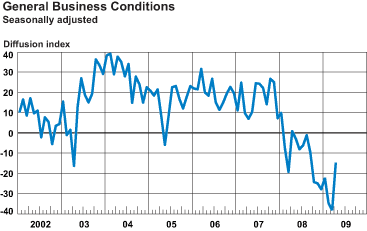April 2009 Report
Survey Indicators
Seasonally Adjusted

The Empire State Manufacturing Survey indicates that conditions for New York manufacturers continued to deteriorate in April, but at a much slower pace than in recent months. The general business conditions index climbed 24 points from its March record low, to -14.7. The new orders index shot up 41 points to a reading just below zero, and the shipments index rose 25 points, also reaching a level near zero. The inventories index continued to fall, hitting a record low -36.0. The indexes for both prices paid and prices received remained negative. The index for number of employees, while negative, improved in April, but the average workweek index fell. Future indexes were much improved, with the future general business conditions, new orders, and shipments indexes rising sharply to levels not seen since September of last year. The capital spending and technology spending indexes remained below zero, although they were considerably above last month’s levels.
In response to a series of supplementary questions, manufacturers generally indicated that factors other than tight credit were largely responsible for weakness in sales (see Supplemental Report tab). A majority of those surveyed reported that their sales had fallen more than 10 percent below their levels in “normal” times. The weak economy and uncertainty about the business outlook were widely cited as factors dampening demand for respondents’ products and services. Most respondents cited little or no difficulty obtaining financing for either long-term commitments (capital investment) or short-term needs (operating expenses). Moreover, fewer than 10 percent of those surveyed indicated that problems obtaining credit had adversely affected their production or sales.
General Business Conditions Index Rises Sharply
The general business conditions index rebounded from the record low set in March, surging 24 points to -14.7. The fraction of respondents that reported improved conditions rose from 10 percent last month to 24 percent in April, and the percentage that reported worsening conditions fell from 48 percent to 39 percent. Although still negative, the new orders index shot up 41 points to -3.9, with 29 percent of respondents reporting an increase in orders. The shipments index also rose dramatically, climbing from -26.7 to -1.8. The unfilled orders index rose less sharply, advancing 6 points to -18.0. The delivery time index rose several points to -5.6. The inventories index fell for a second consecutive month, dropping 9 points to a record-low -36.0.
Price and Employment Indexes Are Little Changed
The prices paid index, at -14.6, was unchanged from March, remaining below zero for a fifth consecutive month. The prices received index rose 6 points to -18.0. The number of employees index remained well below zero but improved to -28.1. The average workweek index fell 5 points to -28.1.
Six-Month Outlook Improves Markedly
Future indexes suggested a significant improvement in the six-month outlook compared with readings in the last few months. The future general business conditions index rose 30 points, to 33.1, its highest level since September of last year. Fifty-one percent of respondents—compared with 38 percent in March—expected conditions to be better six months from now. The future new orders and shipments indexes rose to similarly high levels, and the future unfilled orders index turned positive for the first time this year. The future prices paid index remained just above zero, while the future prices received index was just below zero. The future number of employees index climbed 16 points to -4.6, and the future average workweek index rose above zero. The capital spending index advanced 18 points to -1.1, and the technology spending index rose 19 points to -4.5.










